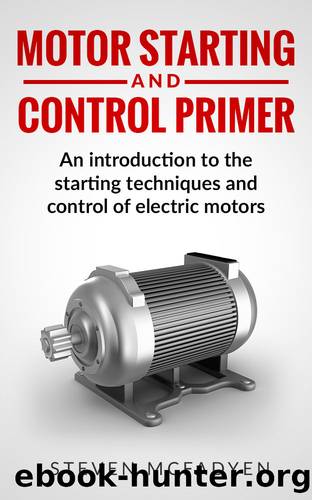Motor Starting and Control Primer: An introduction to the starting techniques and control of electric motors by Steven McFadyen

Author:Steven McFadyen [McFadyen, Steven]
Language: eng
Format: epub
Publisher: Steven McFadyen
Published: 2014-04-24T00:00:00+00:00
Adjustable Starting Parameters
No Break in Motor Supply During Starting
Small Reduction in Peak Current
Resistance Bank Required
Rotor Resistance Starting
Rotor resistance starting, like primary resistance starting, involves the addition of resistors into the external circuit. Unlike primary resistance starting, the resistors are connected into the rotor circuit (for resistor connection into the stator circuit see previous chapter). Rotor resistance starting is more expensive and complex than primary resistance starting due to the requirement of slip rings on the rotor and the switching of resistor banks. However, a significant benefit is that the selection of resistors (torque) can be matched to the mechanical requirement of the load.
During rotor resistance starting, banks of resistors are connected into the rotor circuit at the start. As the motor accelerates the resistor banks are switched out on timers until, at full speed, the motor is running directly connected to the power supply.
In rotor resistance starting the torque is nearly proportional to the line current. For example:
A starting torque of 3 times the normal torque will have a starting current of around 3
times the normal running current.
Download
This site does not store any files on its server. We only index and link to content provided by other sites. Please contact the content providers to delete copyright contents if any and email us, we'll remove relevant links or contents immediately.
| Automotive | Engineering |
| Transportation |
Machine Learning at Scale with H2O by Gregory Keys | David Whiting(3613)
Never by Ken Follett(3520)
Urban Outlaw by Magnus Walker(3241)
OPNsense Beginner to Professional by Julio Cesar Bueno de Camargo(3195)
Sapiens and Homo Deus by Yuval Noah Harari(2842)
Will by Will Smith(2576)
A Short History of Nearly Everything by Bryson Bill(2505)
Hooked: A Dark, Contemporary Romance (Never After Series) by Emily McIntire(2415)
Rationality by Steven Pinker(2148)
Borders by unknow(2116)
Holy Bible (NIV) by Zondervan(2026)
The Becoming by Nora Roberts(1914)
Freedom by Sonny Barger(1716)
The One Percenter Encyclopedia by Bill Hayes(1716)
HBR's 10 Must Reads 2022 by Harvard Business Review(1696)
A Short History of War by Jeremy Black(1668)
Five Ways to Fall by K.A. Tucker(1632)
Girls Auto Clinic Glove Box Guide by Patrice Banks(1618)
Go Tell the Bees That I Am Gone by Diana Gabaldon(1598)
